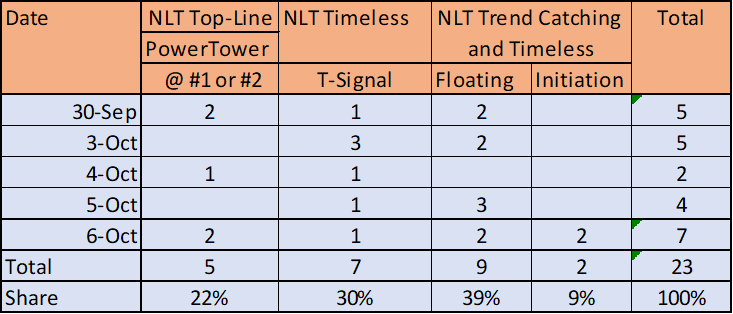Some claim that the stock market development is a random walk; however, this is only the case when you have no tools to analyze the underlying currents of the happening.
We want to invite you to experience and forecast price moves from a new perspective, helping you to participate in up and down movements from any account, even from an IRA.
Read on and watch the movie…

What appears like a chaotic reaction often has an underlying structure to forecast the happening with a high likelihood. Our algorithms see the price development embedded in a Markov chain, where the next happening is correlated to the last occasion and is not totally independent.
What is coming next in the stock market?

The chart shows a two-year development of the NASDAQ 100 and the S&P 500. Since the beginning of the year, the technology-heavy NASDAQ 100 has been underperforming and dragging the indexes down.
What does that mean for your portfolio if you hold one?
The pressure is on:
- There is a solid chance that the indexes will drop another 20% (see the red projection shade on the chart).
- Big money managers already took a substantial hit; why should private investors be spared?
12-Months Development of the Largest Money Managers

The table above shows a substantial market capitalization deterioration over the last twelve months. A typical bear market reaction and your portfolio, so you hold one in the form of an IRA, 401(k), or other conditions, might not look much different, and we have not seen the bottom yet.
However, you can make a difference with instruments on hand that project a change in price direction.
BLK on the Daily NLT Top-Line Chart

Like in a seismic reading, pre-eruptions indicate a potential price movement and extrapolate the incident by what has happened before. In our model, the price needs to move out of containment to fulfill the forecasted move with a high likelihood. This way, we anticipate other market participants to trade along with our directional assumption and drive the price move to the forecasted target.
On the chart, we highlighted four potential price turning points. At each, our NLT Top Line indicators pointed the direction to either buy or sell when the formulated price threshold of buying> or selling< were fulfilled in the price movement of the next candle. This way, buy-stop or sell-stop orders are filled:
Situation-1: Buy > $629.65. The price movement of the next candle took out the price threshold, and a long trade was initiated to the second target dot on the chart, where it got, and the trade was closed. Then you had multiple re-entering opportunities after the candles with the cyan arrow and dot, or you could trail the stop with the red line and the lower side of the blue frame.
Situation-2 had an orange sell signal. This signal occurred as an early directional change signal and was followed up by an NLT PowerTower (red signal, Sell < $712.31) and led to a short trade until the second target dot was reached.
Situation-3: Sell < $643.31. The direction of the trade was confirmed by ticking below the set price threshold, and a short trade to the second target dot followed.
Situation-4: Buy > $578.34 was not accepted as a trade potential. The reason for this: V-Shape reversals occur only in 15% of the cases, and we are probability thinkers and only take high-probability setups. Hence we disregarded this first leg up.
Suppose you are trading from an IRA or Cash Account, where short-selling stock is not allowed by SEC regulations. In that case, you learn to participate in the downside price movement by a simple options strategy with the help of the NLT Delta Force Concept:
- It specifies the stock options Delta you buy
- The time to expiration to pick
- And the maximum price to pay for the option
Our concept demystifies options trading and gives you a clear perspective of what to do, how, and when.
For day traders, we are working on an idea where we encourage them to trade less, not more, to reduce the failure rate.
We combine multiple indicators in the chart example of Friday, October 21, 2022.
The chart shows three validated trade indications that came to the pre-defined target.
- Dots on the chart are targets
- Red crossbars are the stops
- Buy and Sell thresholds indicate opportunities
E-Mini S&P 500 Timeless Day Trading Chart

As a trader, you are handling probabilities and only want to risk your money when the odds are in your favor. So let us invite you to two ideas of how to address today’s markets:
- As a day trader using NLT Timeless Charts with system-compliant reward/risk setups
- As a swing trader or longer-term investor, learning how to operate during the earnings season
We have two publications ready for you, reply if you want to learn more, and we will be happy to share our findings.
contact@NeverLossTrading.com Subj.: Day Trading
contact@NeverLossTrading.com Subj.: Swing Trading
To succeed in trading, you best work with an experienced coach and learn much about trading. Our #1 competitive advantage is the support and customer service we offer. We work one-on-one with you to specify what we teach to your specific wants and needs; hence, if your knowledge base is not expanding rapidly, you are doing something wrong.
Ongoing education and mentoring are crucial to longevity in this business. Veteran traders have been through more ups and downs than you can imagine. So, experienced pros have probably experienced whatever you’re going through.
If you are ready to make a difference in your trading:
We are happy to share our experiences and help you build your trading business. Trading is not a typical career, and you best learn from those who are long-term in this business to cope with the rollercoaster of the financial markets. We are here to help and provide feedback on what you might be doing right or wrong.
Strive for improved trading results, and we will find out which of our systems suits you best.
The markets changed, and if you do not change your trading strategies with them, it can be a very costly undertaking.
We are happy to hear back from you,
Thomas Barmann (inventor and founder of NeverLossTrading)
Disclaimer, Terms and Conditions, Privacy | Customer Support















